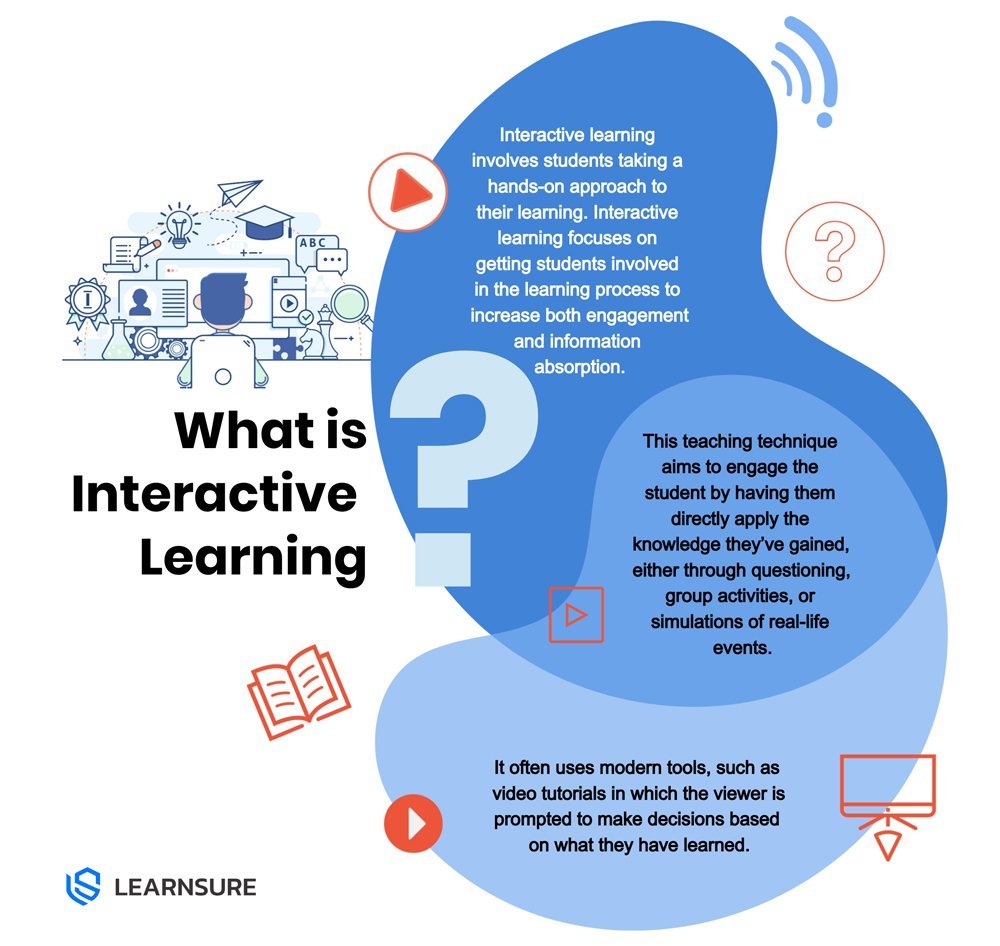Interactive learning for training and development
In 2016, researchers from Carnegie Mellon University conducted a study comparing Massive Open Online Courses (MOOCs) against Open Learning Initiative (OLI) courses. A MOOC is a traditional course in which students learned by watching instructional videos. OLIs are interactive learning courses where students took part directly in the learning process.
The study found that the interactive learning courses were six times more likely to engage and help students learn than a MOOC.
This tells us that interactive learning is an effective tool that companies should begin incorporating into their training solutions.
But what is interactive learning?
Furthermore, are there other reasons your business should integrate this learning technique into your learning management system (LMS)?
This article answers those questions.

What Is Interactive Learning?
As the name suggests, interactive learning involves students taking a hands-on approach to their learning. This teaching technique aims to engage the student by having them directly apply the knowledge they’ve gained, either through questioning, group activities, or simulations of real-life events.
Interactive learning encourages social discourse between the student and educator, thus altering the dynamics in a classroom so that students no longer passively take in whatever the educator says. This learning style often uses modern tools, such as video tutorials and interactive presentations on Learning Experience Platforms in which the in which the viewer is prompted to make decisions based on what they have learned.
In short, interactive learning focuses on getting students involved in the learning process to increase both engagement and information absorption.
Why Should My Organization Implement Interactive Learning?
Interactive learning has become an essential part of many training programs in the corporate world. If you have yet to implement it into your e-learning program or training solutions, these are the reasons why you should consider a change.
Reason No. 1 – E-Learning Increases Engagement
According to statistics shared by research.com, interactive learning is responsible for a 50% increase in student engagement.
Engagement is key to the learning process. An unengaged student will learn little, if anything, in a traditional classroom setting. Their lack of engagement results in them disconnecting from the material being taught, which is damaging to your organization as it means the individual is then unable to apply what they should have learned while training.
By increasing engagement, you make employees active participants in your training solutions, ensuring they retain more knowledge and can better apply that knowledge in the workplace.
Reason No. 2 – Real-Time Feedback for Students and Educators
Through interactive learning, students get real-time feedback on their efforts. For example, a decision-based digital learning program will provide instant feedback based on the student’s choices. If the student is working through an interactive video, they could even see a whole series of decisions play out, much as you’d see in a “choose your own adventure” novel. By the time the video has concluded, the student will better understand the choices they made and where they may have made mistakes along the way.
This feedback also applies to educators. When engaging directly with students, an educator can better understand whether the information they deliver is being absorbed. This is not the case with a traditional lecture, in which the educator receives no feedback during the session.
Reason No. 3 – Fostering Creativity
According to PWC’s 2017 survey, The talent challenge: Harnessing the power of human skills in the machine age, the skills of creativity and innovation are at a premium for CEOs. In fact, 77% of CEOs say they struggle to find employees that have these two skills.
By taking an interactive approach to learning, you foster both of these skills by encouraging employees to actively think about the problems presented to them. If your learning experience platform (LXP) can encourage employees to explore work problems on their own, it encourages them to find solutions they may not learn about in the classroom.
Reason No. 4 – Turning the Theoretical Into the Practical
An employee may be able to describe all of the theoretical aspects of a work action following a traditional classroom session. However, this does not mean the same employee can then apply that theory in practice. It’s only when the relevant challenge arises that they’ll have the chance. The employee may be less certain about the theory by that point, making the practical aspect even more challenging.
Interactive learning bridges the gap between the theoretical and the practical. It provides students with a chance to put what they learn into practice, meaning they’ll be better prepared when facing the same challenges in a real workplace scenario.
Reason No. 5 – Increased Motivation
In 2020, researchers conducted a study to determine whether using augmented reality (AR) technology to create an interactive learning experience would lead to increased motivation to learn on the part of students. The researchers created a five-point scale to measure the following attributes:
- Attention
- Relevance
- Confidence
- Satisfaction
They reasoned that achieving high scores in each area would show that students were more motivated to learn when exposed to this innovative digital learning experience.
After quizzing the participants, the study generated the following mean scores:
- Attention – 4.19
- Relevance – 4.09
- Confidence – 4.20
- Satisfaction – 4.26
The conclusion was that the use of AR technology made the learning environment more engaging and exciting, increasing the students’ desire to learn.
While your organization may not have access to AR technology, this study shows us that interactive learning environments motivate students to engage with the material. Motivation leads to higher engagement, which results in greater information retention and improved work outcomes.
Interactivity Creates Results
No matter your industry, be it banking, finance, insurance, or anything else, interactive training solutions improve student results.
It increases the motivation to learn, resulting in higher engagement levels with the material. Furthermore, interactivity provides your employees with real-time feedback as they learn, thus highlighting the effects of their choices so they can make better decisions in real-life scenarios. Finally, interactive learning fosters creativity, making it more likely that your people will be able to come up with solutions to complex business challenges.
At Learnsure Ai, we can help you add interactivity to your learning experience. Our experts will come up with a custom e-learning solution that fits the learning goals of your organisation.


